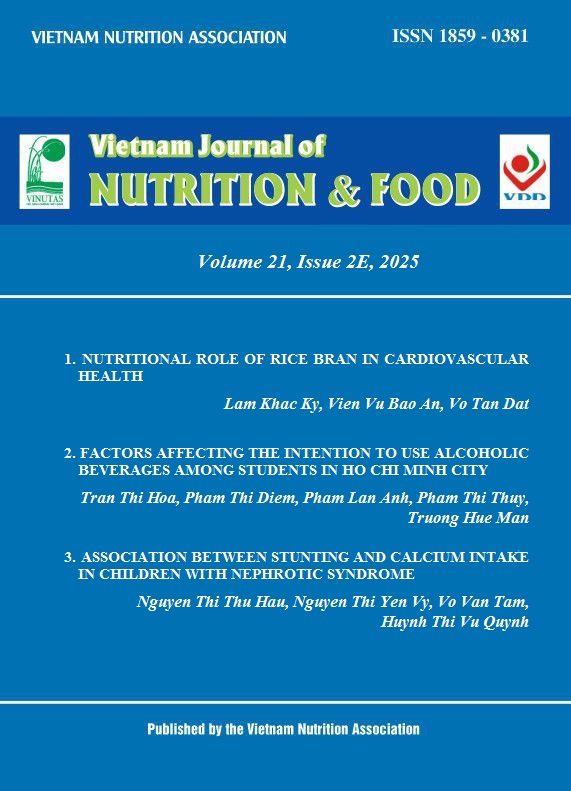ASSOCIATION OF ANTHROPOMETRIC INDICES, NUTRITIONAL HABITS, AND LIFESTYLE FACTORS WITH METABOLIC SYNDROME IN ELDERLY IN NGHE AN PROVINCE
Main Article Content
Abstract
Aims: To investigate the association of anthropometric indices, nutritional habits, and lifestyle factors with MetS (MetS) in elderly.
Methods: This cross-sectional study was conducted on 652 elderly residing in two communes of Nghi Loc district, Nghe An province, from September 2020 to October 2021. Multivariable logistic regression was applied to investigate the association.
Results: The strongest associated factors with MetS were increased total cholesterol (OR=25.6, p=0.001), smoking >10 cigarettes/day (OR=4.30, p=0.005), frequent consumption of salty foods (OR=3.20, p=0.012), and dyslipidemia (OR=2.45, p=0.01). The moderately associated factors were found to be smoking >10 years (OR=2.05, p=0.02), consumption of animal fat (OR=1.95, p=0.022), diabetes (OR=1.95, p=0.025). Inactive physical activity, consumption of sweets/sugar, consumption of animal organs, increased blood pressure, and other lipid profile were also factors associated with MetS (OR=1.10-1,85).
Conclusion: There is a significant association of anthropometric indices, lipid profile, and dietary habits with MetS among the elderly.
Keywords
metabolic syndrome, nutritional habits, anthropometric indices, elderly
Article Details
References
2. Vietnam National Institute of Nutrition (2020), National Nutrition Overview Report 2020.
3. Misra Anoop, Khurana Lokesh (2008). Obesity and the MetS in developing countries. The Journal of Clinical Endocrinology Metabolism, 93(11_supplement_1): s9-s30.
4. Hu Frank B (2002). Dietary pattern analysis: a new direction in nutritional epidemiology. Current opinion in lipidology, 13(1): 3-9.
5. Dang Anh Kim, Le Huong Thi, Nguyen Giang Thu, et al. (2022). Prevalence of MetS and its related factors among Vietnamese people: A systematic review and meta-analysis. Diabetes Metabolic Syndrome: Clinical Research Reviews, 16(4): 102477.
6. Expert Panel on Detection Evaluation, and Treatment of High Blood Cholesterol in Adults (2001). Executive Summary of the Third Report of the National Cholesterol Education Program (NCEP) Expert Panel on Detection, Evaluation, and Treatment of High Blood Cholesterol in Adults (Adult Treatment Panel III). JAMA: The Journal of the American Medical Association, 285(19): 2486-2497.
7. Vietnam Ministry of Health (2019), Guidelines for diagnosis, treatment and management of some non-communicable diseases at commune health stations.
8. Tan KCB (2004). Appropriate body-mass index for Asian populations and its implications for policy and intervention strategies. The lancet.
9. World Health Organization (1998). Preventing and Managing the global epidemic. Geneva: Switzerland, obesity RoaWco.
10. Vietnam Ministry of Health (2014), Guidelines for diagnosis and treatment of endocrine and metabolic diseases.
11. Rosenson R.S. (2024). Patient education: High cholesterol and lipids (Beyond the Basics). Uptodate.
12. Centers for Disease Control and Prevention (US) (2017), Adult Tobacco Use nformation, General Concepts.
13. Scollo Michelle, Hayes Linda, Wakefield Melanie (2013). What price quitting? The price of cigarettes at which smokers say they would seriously consider trying to quit. BMC public health, 13: 1-12.
14. World Health Organization (2008), Part 4: Conducting the Survey, Data Entry, Data Analysis and Reporting and Disseminating. WHO STEPS Surveillance Manual, WHO Library Cataloguing-in-Publication Data.
15. World Health Organization (2008). Part 6: Templates and Forms. WHO STEPS Surveillance Manual, WHO Library Cataloguing-in-Publication Data.
16. World Health Organization (2020), Salt reduction. Available at: https://www.who.int/news-room/fact-sheets/detail/salt-reduction.
17. World Health Organization (2015), Guideline: Sugars intake for adults and children. Available at: https://www.who.int/publications/i/item/9789241549028.
18. Hu F. B., Willett W. C. (2002). Optimal diets for prevention of coronary heart disease. JAMA, 288(20): 2569-2578.
19. World Health Organization (2008). Part 5: STEPS Instrument. WHO STEPS Surveillance Manual, WHO Library Cataloguing-in-Publication Data.
20. Rigamonti Antonello E, Cicolini Sabrina, Tamini Sofia, et al. (2021). The Age‐Dependent Increase of MetS Requires More Extensive and Aggressive Non‐Pharmacological and Pharmacological Interventions: A Cross‐Sectional Study in an Italian Cohort of Obese Women. International journal of endocrinology, 2021(1): 5576286.
21. Block Andrea, Schipf Sabine, Van der Auwera Sandra, et al. (2016). Sex-and age-specific associations between major depressive disorder and MetS in two general population samples in Germany. Nordic journal of psychiatry, 70(8): 611-620.
22. Cheong Kee C, Ghazali Sumarni M, Hock Lim K, et al. (2015). The discriminative ability of waist circumference, body mass index and waist-to-hip ratio in identifying metabolic syndrome: Variations by age, sex and race. Diabetes Metabolic Syndrome: Clinical Research Reviews, 9(2): 74-78.
23. Oh Sarah Soyeon, Jang Ji-Eun, Lee Doo-Woong, et al. (2020). Cigarette type or smoking history: Which has a greater impact on the MetS and its components? Scientific reports, 10(1): 10467.
24. Santos A-C, Ebrahim S, Barros H (2007). Alcohol intake, smoking, sleeping hours, physical activity and the metabolic syndrome. Preventive medicine, 44(4): 328-334.
25. Katano Sayuri, Nakamura Yasuyuki, Nakamura Aki, et al. (2010). Relationship among physical activity, smoking, drinking and clustering of the MetS diagnostic components. Journal of atherosclerosis, 17(6): 644-650.
26. Yoshida Junko, Eguchi Eri, Nagaoka Kenjiro, et al. (2018). Association of night eating habits with MetS and its components: a longitudinal study. BMC public health, 18: 1-12.
27. Shin Aesun, Lim Sun-Young, Sung Joohon, et al. (2009). Dietary intake, eating habits, and MetS in Korean men. Journal of the American Dietetic Association, 109(4): 633-640.
28. Onat Altan, Ceyhan Köksal, Başar Ömer, et al. (2002). Metabolic syndrome: major impact on coronary risk in a population with low cholesterol levels—a prospective and cross-sectional evaluation. Atherosclerosis, 165(2): 285-292.
29. Doyle Suzanne L, Donohoe Claire L, Lysaght Joanne, et al. (2012). Visceral obesity, metabolic syndrome, insulin resistance and cancer. Proceedings of the Nutrition Society, 71(1): 181-189.
30. Morse Stephen A, Zhang Rubin, Thakur Vashu, et al. (2005). Hypertension and the metabolic syndrome. The American journal of the medical sciences, 330(6): 303-310.
31. Dalle Grave R, Calugi S, Centis E, et al. Lifestyle modification in the management of the metabolic syndrome: achievements and challenges. Diabetes Metab Syndr Obes. 2010;3:373-385.


